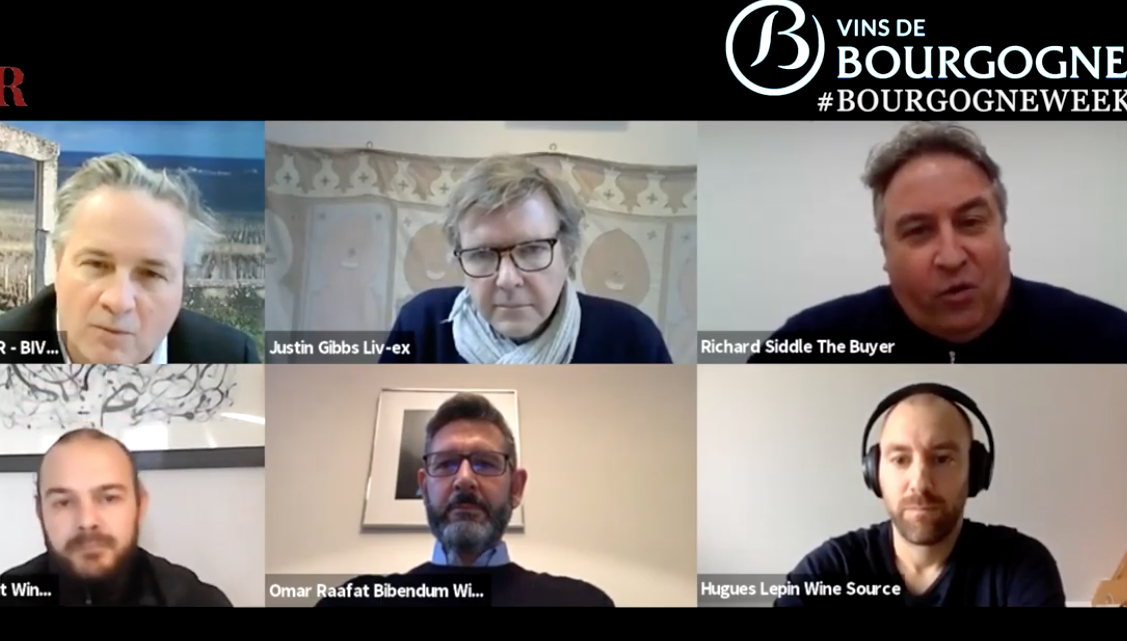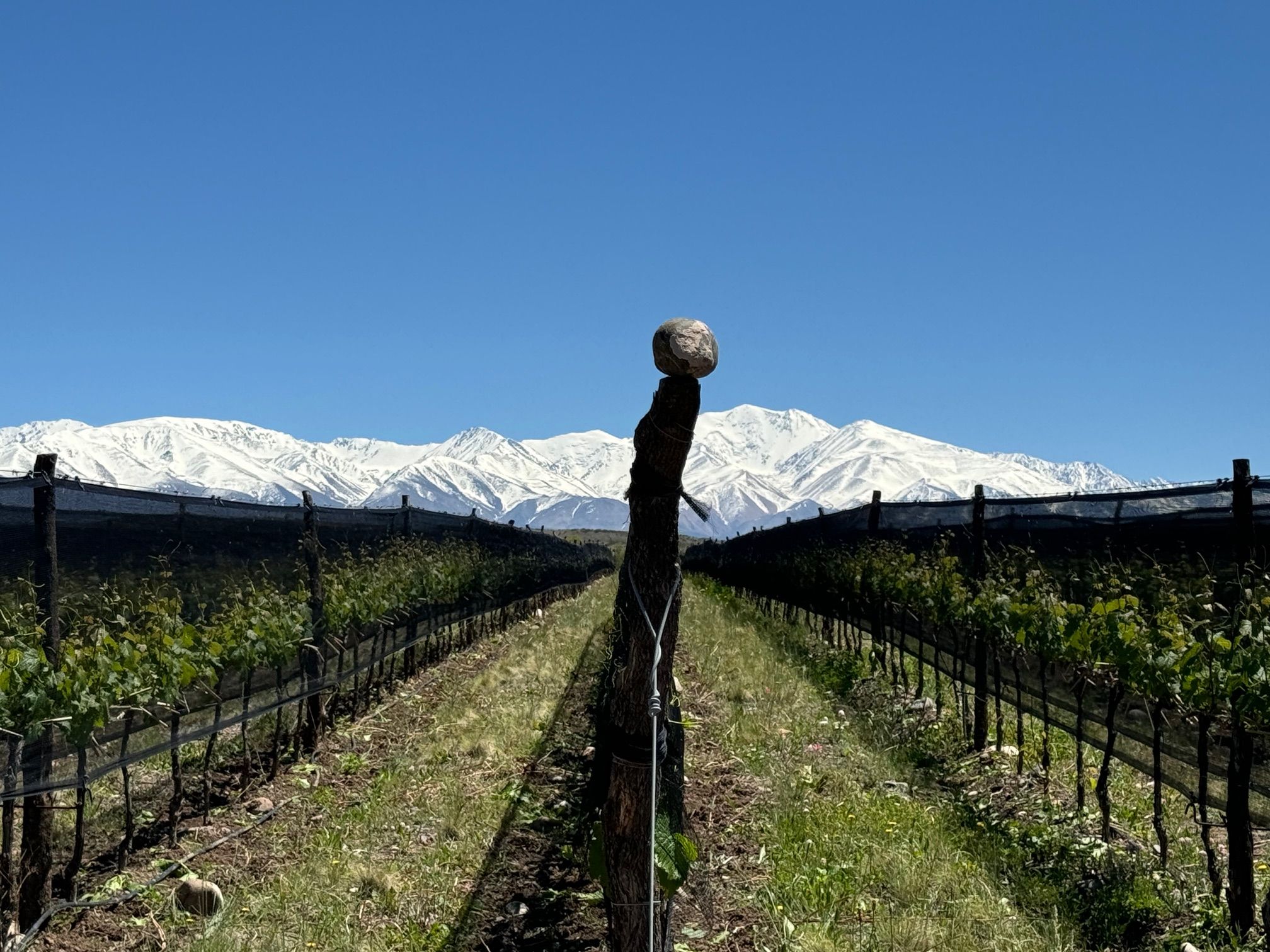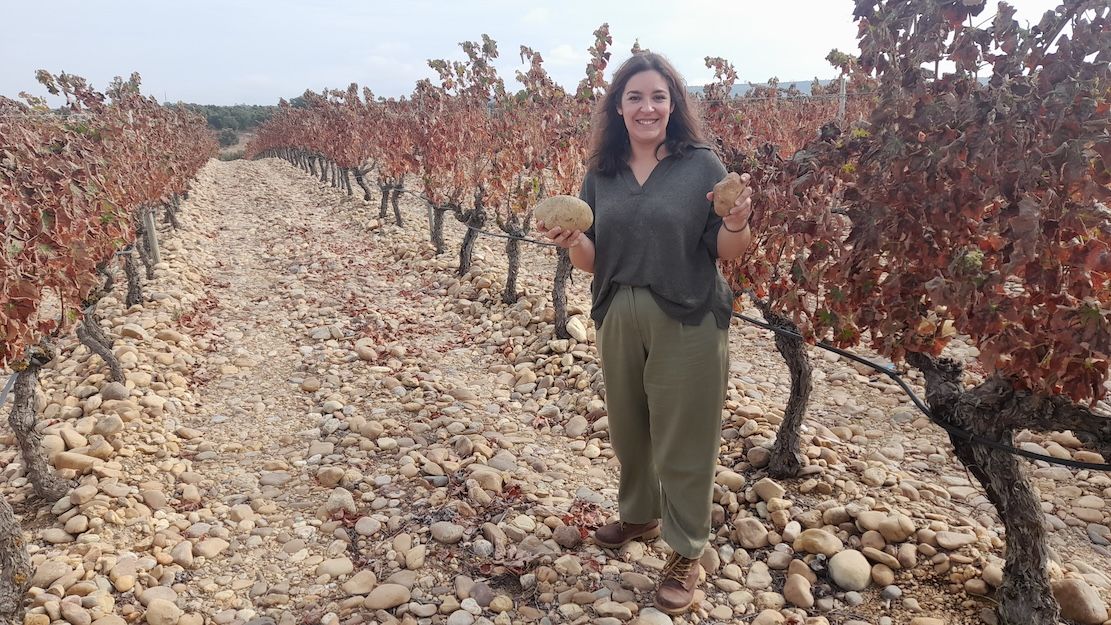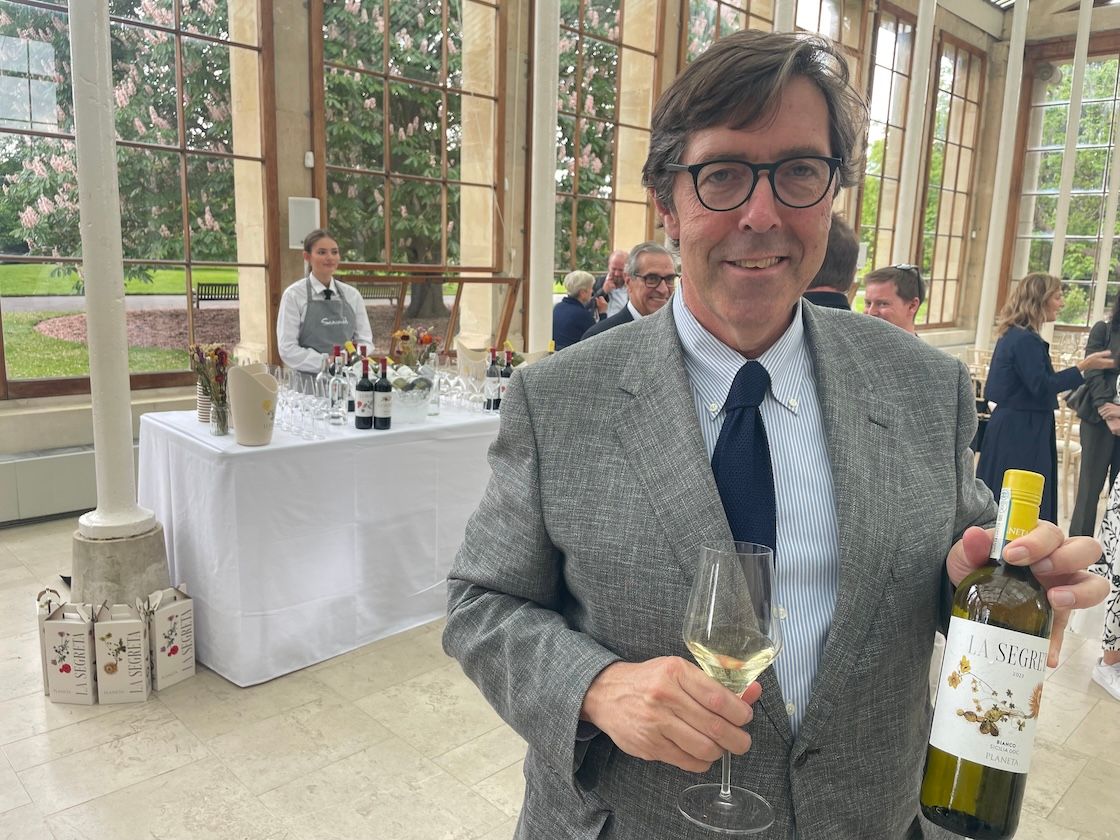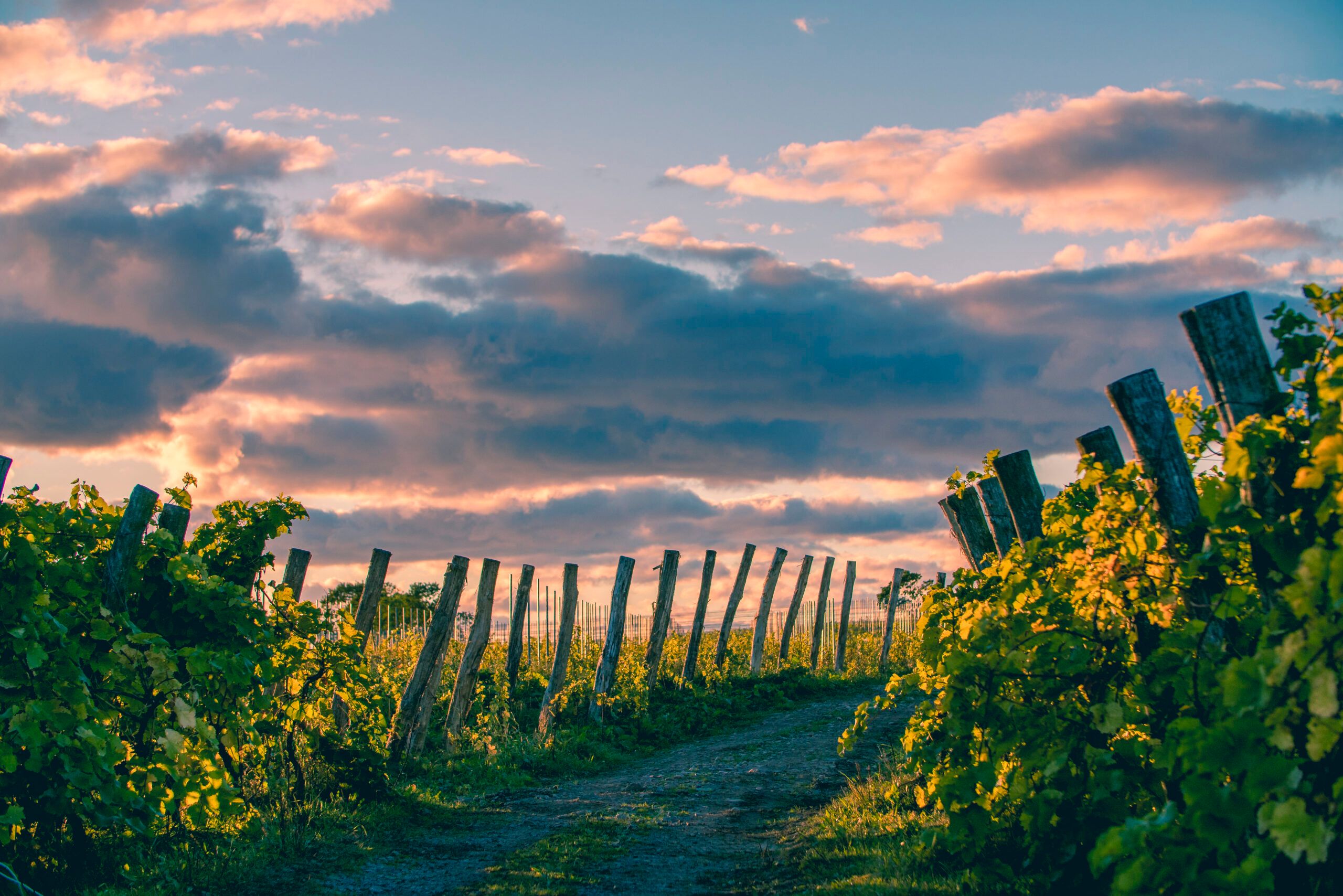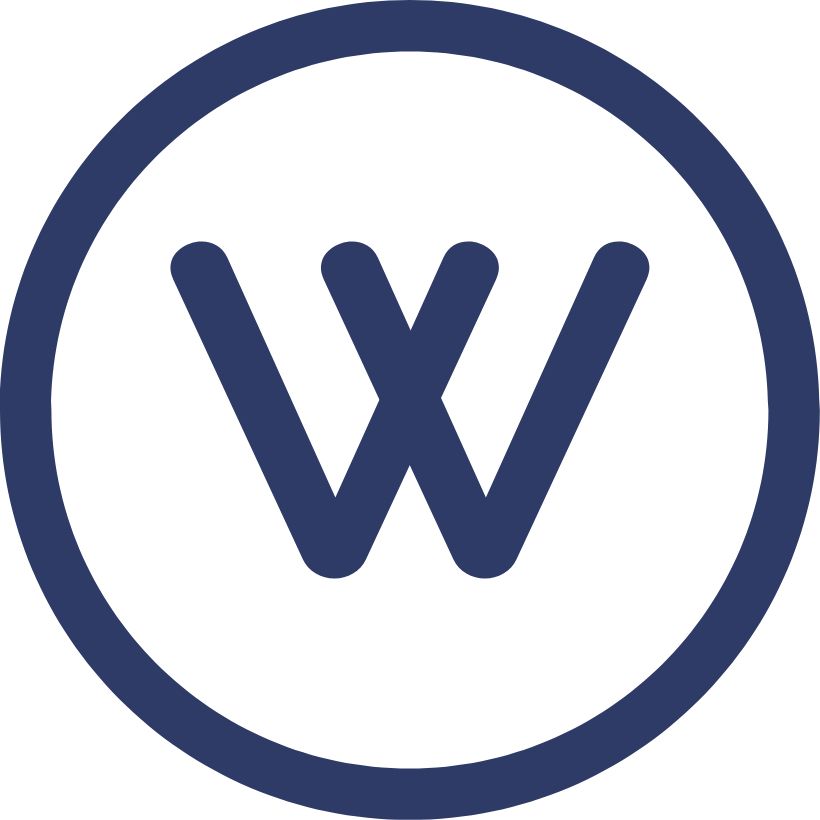The Buyer and BIVB Bourgogne Leaders Debate helps set the agenda for this vital region for importers, distributors, buyers and producers alike as we head into Bourgogne Week.
(Click here to watch the full Bourgogne Leaders debate)
In any normal year the first weeks of January are dominated by the vast number of importer and distributor tastings showcasing and presenting the newly released vintage as part of Bourgogne’s en primeur campaign. This year, though, is very different. Any tastings taking place are being done at home, or in the privacy of company offices, with Covid-19 regulations continue to restrict the usual day to day workings of the wine trade.
It’s why The Buyer has teamed up with the Bourgogne Wine Board (the BIVB) to present a series of online debates featuring key figures in the UK wine supply chain along with leading Bourgogne producers in order to hear first hand what the opportunities, challenges and key trends that are going to be the most important for the region in the year ahead.
We start the series today with a major online debate between four leading UK players, who were able to discuss what they see as being the driving forces behind Bourgogne with president of the BIVB, Louis-Fabrice Latour, head of the famous family négociant.
Representing the UK trade are:
- Omar Raafat, fine wine director at Bibendum.
- Nicolas Clerc MS, wine buyer for Armit Wines.
- Justin Gibbs, co-founder of Liv-ex.
- Hugues Lepin, private client director, Wine Source.
Setting the scene: how important is Bourgogne to your business?
To help set the scene each of the panellists were able to explain just how important the Bourgogne region is to each of their businesses.
Omar Raafat said Bourgogne was incredibly important to Bibendum’s overall range and its ability to be able to offer the market a full spectrum of wine from bulk, volume wines right up the pricing ladder to premium and fine wines. It plays a “pivotal role” he says in the “credibility for our offer” particular at the premium end of the on-trade market. If you can show quality and diversity in Bourgogne and Bordeaux it breeds confidence in the rest of the list, says Raafat.
Although the region as a whole might only contribute around 3% of Bibendum’s total annual sales it crucially allows it to sell wines at two and a half times more than does it on average across the board. At the premium end it is certainly the biggest of all regions, including Bordeaux, he adds. In sales terms Chablis is particularly important for Bibendum, says Raafat.
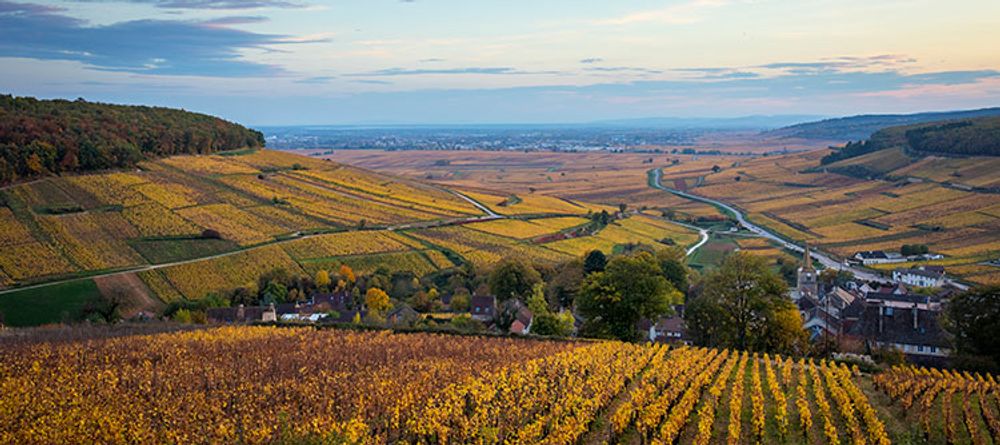
The patchwork of different sized vineyards that make up the vista of Régionale appellations across Bourgogne
Bourgogne’s ability to make wines for all sectors of the market makes it a vital region for a multi-channel distributor like Armit Wines, says Nicolas Clerc MS. It now works with around 30 producers across the region which represent between 8% to 12% of the company’s turnover, depending on the vintage.
Bourgogne has been an “essential” region for Wine Source, says Hugues Lepin, as it has built up its business over the last 10 years, developing its private customer base (65% of its business) as well as its strong on-trade network (35%), primarily in London, but also now with offices in New York and Bordeaux.
Bourgogne was also the first region where it started working with directly with producers, and it now has a strong portfolio, predominantly in red wine. “It is such an important region particularly for our UK and London based clients as they are such Bourgogne lovers.”
Justin Gibbs at Liv-ex was able to give what he calls more of an “independent view” of what trends it is seeing within the Bourgogne category. “We have no skin in this game from a commercial perspective. We make our crust from selling our data,” is how he explains Liv-ex’s role as a fine wine index and trading platform. “The action is set by the merchants members who transact through the platform.”
2020: The Bourgogne view
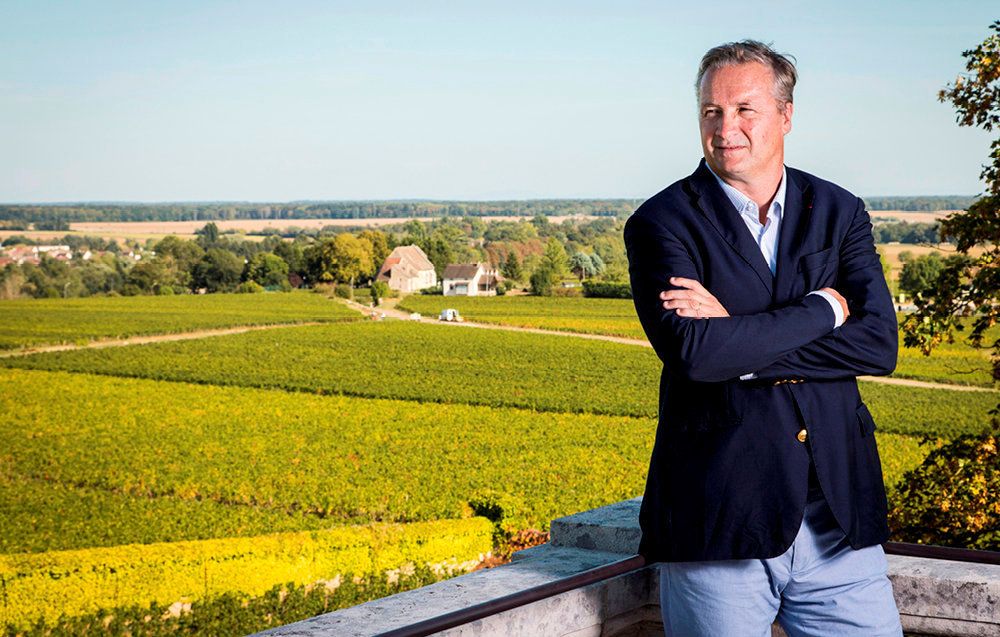
BIVB president Louis-Fabrice Latour says the support of the UK market in 2020 has been crucial for the Bourgogne region as a whole
Louis-Fabrice Latour was able to give the perspective from Bourgogne and say the region can actually look back on 2020 with a great deal of satisfaction.
“We had a pretty good year. From a vintage point of view 2020 is looking very good and we have been able to achieve a vintage that is very balanced. It’s also showing a nice acidity, which is very important for the image of Bourgogne and shows we are not making wines with 14% alcohol,” he explains.
It is also further evidence of the consistency there now is in the region and the fact it has continuously made “good wines” through the 2016, 17, 18, 19 and now 20 vintages.
“We have four very good vintages in a row and that has helped us in what has been a very challenging time,” he adds.
Looking at overall export figures for 2020 Latour was able to confirm that Bourgogne has only seen a slip of 7% in total global export values, and 3% to 4% in volume despite the problems around the world with Covid-19. Domestically the figure is likely to be nearer 15% to 20% down.
The UK, though, has been its stand out success story in 2020 as it has once again become Bourgogne’s number one export market, overtaking the US, with volumes up to the end of October up by 10% and 2% in value, says Latour. “Thanks to the UK market we are showing some relatively good figures,” he adds.
Despite the Covid difficulties, the region as a whole is in a healthy position, says Latour, thanks to the recent strong vintages and the fact it has good supplies in its cellars from the last two years in particular. Which means it can also promise the trade a strong period of “stability” when it comes to pricing in the months ahead.
“Even though it has been difficult because of Covid, Bourgogne is still standing up with good wines and good vintages…so 2020 has been relatively good to Bourgogne.”
Again he is quick to thank the UK and its wine buying public for supporting the region during this time. “In times of recession you lose some sales, yes, but you also gain because people are going back to what they know, and what to they know better in the UK than Bourgogne, with perhaps Bordeaux and Champagne?”
In terms of its hopes for the year ahead then Latour is particularly keen to sell more red wines in the UK, to complement the demand for Chablis.
2020: How the UK trade responded
(Omar Raafat, fine wine director at Bibendum, on how UK buyers responded to Covid-19)
It’s hard to look too far forward into 20201 without reflecting on the huge impact that Covid-19 has had on the trade and how it was able to work in 2019.
For the three importers on the panel it was really a case of being able to cope with effectively the on-trade being closed for so much of the year, and the need to switch resources and sales into what were the buoyant off-trade and online sales.
Raafat says 2020 was very much about managing supply levels in the UK, and looking specifically at the Bourgogne category, although overall sales are down, particularly the national on-trade customers, certain sectors, like regional wholesale, have remained stable.
“But then independent retailers have seen three or four fold increase in their Bourgogne sales,” he adds.
Where there has been a lift in multiple off-trade sales at Bibendum, they have tended to be for Mâcon, Chablis and generic Bourgogne wines.
Then there have been those in the on-trade that have done well with delivery and click and collect services where Bibendum was able to help with the launch of its Local delivery app. That gave Raafat and his team the chance to work with pubs and restaurants with mini lists of wines, including Bourgogne, that they would not normally sell.
“They found customers were actually spending more than they normally would have done and were able to sell better quality wines. This worked in favour for a region like Bourgogne,” says Raafat.
Clerc at Armit Wines believes it actually ended the year in a stronger position than it started it, by being able to manage and handle their stock levels and switching supply to the customers that needed it. “With some bad, comes some good,” he says.
Which for Bourgogne meant being able to use more of its supplies of the 2017 and 2018 vintages it had in reserve, and really focus in on pushing wines that were at drinkable age.
Lepin says Wine Source “also took the time to look into our own stock” to select and promote wines that are ready to drink now. “That’s what people wanted. All those wines that are amazing to drink with a few years ageing in the cellar that are ready to be tasted.”
The rise in e-commerce
Wine Source also started for the first time its own e-commerce arm to compensate for the on-trade closing down and the opportunity to develop new sales. This, in turn, then gave it the platform on which to continue its tasting program and introduce its producers – via Zoom etc. – to both existing and new customers.

Liv-ex’s Justin Gibbs: There has been a “move towards automation of trade” during 2020
Justin Gibbs says Liv-ex had a key advantage during 2020 of running a business that was already 100% online and it was able to work closely with its merchant members in helping them switch their models from largely on-trade to developing their private client business.
Those who were already predominantly dealing with private clients reported sales in the initial lockdown that were strong than the Christmas before, he adds.
Overall, there has been a “move towards automation of trade as much as possible” during 2020 “and that is a trend going forward”.
Liv-ex has been able to strengthen its position as being the digital platform through which buyers and sellers, globally, can openly see what stock is available in the market at any given time and set the parameters through which they would like to do business.
The move to digital has been so pronounced during 2020 that “automated transactions” where neither buyer or seller actually “touches the screen” accounted for 40% of all Liv-ex transactions in November, compared to around 20% at the start of the year, says Gibbs. “That connectivity, that e-commerce driven trend, has probably only just begun.”
“The liquidity and breadth of the market has grown enormously. We started the year with about £50m worth of live, bid/offer exposure and we are now sitting on £82m worth of bid/offer exposure, of which 20% is Bourgogne. That is a lot of numbers and we intend to invest through 2021 to be able to extract that data, analyse it and share it amongst our members.”
Sourcing, tasting and working with Bourgogne producers through 2020
With so much of the on-trade closed for large parts of the year, Raafat says it has spent far more time than usual looking internally at what it could do as a business to keep talking and working with customers and responding to their needs. Which, in turn, has meant working far more with its producers in hosting tastings and involving them in those online meetings.
“Most of that was done with stock that we were holding and we weren’t really looking to take on new producers or shift the next vintage. It was very much understanding what we had and making sure the teams were all up to date on that,” he explains.
It has also been a good opportunity to involve its regional sales teams far more in online tastings with key producers that it would not normally have done. “That’s been an upside in how we do things and that will continue,” he adds as it has allowed key producers to build relationships and “get to spend time with those team members and customers more easily than they have done in the past”.
The big difference in 2020, stresses Raafat, is that any new prospect conversations in the on-trade ended up not being about doing business three to four months down the line, but lining activity up hopefully for March, April 2021 when the market hopefully picks up.

Nicolas Clerc MS was able to travel and taste and meet Armit partners in Bourgogne during 2020
Clerc at Armit Wines was able to spend a number of weeks in France during 2020 visiting its producers and travelling to key regions such as Bourgogne and, like, Lepin, having the chance to really sit down and spend time with their key winery partners.
“I am a lucky man as I am full of the 2019 Bourgogne vintage,” he says.
Lepin did not have the problem of not being able to see producers directly as he is based in France, so has actually had the opportunity to build even closer contacts with producers through personal visits to key regions like Bourgogne.
“As I was not travelling outside France I took even more time to go and see the producers that we love,” he says, spending more time per visit than would normally be possible to explore how they can grow their business together.
Just having that extra time has been invaluable in building those relationships, he says. Yes, every importer has been under pressure to find new ways to do business, but there has also been “plenty of time to think about how we can get better at what we do”.
His problem, heading up private sales, has not been able to see any of his key customers in the UK. “That has been extremely difficult.”
Frustration for Bourgogne producers
It has equally been a “frustrating” time for producers and the Bourgogne region not being able to host and show what they can do for all their key partners around the world, says Louis-Fabrice Latour.
“The biggest challenge has been to introduce into the new market some new appellations or to gain new customers,” he says.
Even introducing the 2018 vintage has been “very frustrating” and it has had to cancel so many tastings and opportunities where it can sit down with its key customers. Whilst he is confident the market overall can survive what is effectively a year of doing business in this way, it is not something that is sustainable long term and he is anxious to see the situation resolved as much as it can be in the coming months.
Bourgogne trends in the UK in 2020
(Nicolas Clerc MS, wine buyer for Armit Wines, on overall trends in 2020 for Bourgogne wine sales)
Clerc says the fact we have all been mainly stuck at home for so much of 2020 has resulted in a clear shift in what styles of Bourgogne wines have been bought and drunk, which has largely been “the perfect fit” for the more value for money Village and Régionale appellation wines as well as the familiar Chablis and Mâcon wines.
So for merchants like Armit it has been a good opportunity to stretch where those value for money wines can come from, with good opportunities for appellations like Bourgogne Hautes Côtes de Beaune, Bourgogne Hautes Côtes de Nuits and younger and fresher vintages.
“We were lucky to have the 17 and 18 vintages. Those wines are beautiful, they are open, they are approachable when they are young. They were key,” he adds, but stresses it may not be as easy with the smaller 2019 vintage.
Major focus on white wines
As so much of Bibendum’s Bourgogne sales go through the on-trade it means it is “heavily driven” by white wines, says Raafat, accounting for 80% of its value sales from the region. This year the proportion is nearer 90% white and 10% red.
How that breaks down regionally has not changed too much in 2020, with 45% being Chablis sales, 30% Côte d’Or, 10% Mâcon and 5% Régionale appellations, he says. “We’re very much driven by Village level wines – about 70% of what we do is again very much focused on Chablis.”
The one area that has shifted this year has been double the demand for Village Premier Cru and Grand Cru wines through restaurants, where clearly customers are taking advantage of eating out for the first time in a few months by trading up.
It remains to be seen whether those sales can be sustained when the market comes back, but it will have at least given more people the chance to try and enjoy that level of wine. “That will perhaps open their eyes to why there is a price point difference,” he says.
There has been similar trading up taking place in the specialist independent trade where the merchant can act like a sommelier and help introduce new wines to people. Bibendum has seen independents increase their sales of Bourgogne wines by 40% to 50% during 2020 and is hopeful that can continue. “It’s about understanding your customer and picking the right wine for them,” says Raafat.
Hugues says he has also seen his private customers be a lot more “open minded” about the Bourgogne wines they were buying, with particular demand for Pouilly Fuissé, other parts of the Maconnais, Chablis and more premium appellations. He has also seen more people trading up to Village Premier Cru and Grand Cru and just being far more open to discovering and trying more premium wines.
“I was extremely surprised to see them willing to discover and talk about new wines. It was great to show them even some of the more difficult vintages,” he says.
Secondary market Bourgogne trends
(Justin Gibbs, co-founder of Liv-ex, on secondary market trends in Bourgogne)
From a secondary market point of view Liv-ex was able to see the growth and interest there has been in Bourgogne over the last 10 years sustain itself through 2020. Over the last decade Bourgogne has benefited hugely from the pricing problems that Bordeaux has had, taking its secondary market share from 1% in 2010 to 20% by the end of 2019, explains Gibbs. Bourgogne prices have gone up 150% in that time, versus 40% for the secondary market overall, and 20% for Bordeaux.
There has been a slight retraction in 2020 with Bourgogne’s value share down to 18%, but, stresses Gibbs, its volume sales have been maintained which shows people are not leaving the category, as he explains: “The lure of Bourgogne is still very much there, but they are now looking for value and lesser known appellations.”
It has also seen during 2020 a 35% increase in the number of actual wines available on the Liv-ex site. “This is people beginning to understand Bourgogne better, there is more connectivity, more transparency,” all helped by the individual merchants playing their part bringing more wines and customers into the market.
The case for Bourgogne on the secondary market has been made through its most prestigious wines, which is now opening the door for more growers and producers to trade their wines, he adds.
How diversity is now key for Bourgogne
(Louis-Fabrice Latour, BIVB president, on how diversity is now key for Bourgogne)
Louis-Fabrice Latour says it is also important to remember that 50% of Bourgogne wines are made up of Régionale appellations and there has been a lot of work done in key areas, such as Chablis and the Maconnais, to be competitive on price, and it is now benefiting from the multiple channels where it can sell those wines. “That has helped Bourgogne maintain its market share in the UK and worldwide,” he says.
As well as having that “diversity in appellation” the region is also well served by its “diversity of operators” from growers, to co-ops, the negociants and domain owners all playing their part in best representing its wines and maintaining its market share.
He was pleased to hear how well the 2017 vintage has done in the UK market and is confident the “more powerful” 2018 vintage will also help keep Bourgogne’s momentum going.
“This recession has come at a time when we have a very nice diversity in terms of style of vintages. If it had come 10 years ago our lives would have been much more challenging,” he adds.
Where is the potential for growth for Bourgogne in the UK?
While white Bourgogne sales might be doing so well in the UK, around the world it is the strong performance of its red wines that is particularly pleasing for Latour and the region. “This is our big surprise so far this year,” he says.
That said the BIVB would also like to see a better balance between red and white wines sales in the key UK market, says Latour, and it is a “bit of a puzzle” why white wine sales are so dominant. “There is a bit of frustration on that side.”
Raafat can certainly see “considerable” room for growth for red wine sales in the on-trade, but says it is the sheer benchmark quality of Chardonnay and Chablis that means it is such a powerhouse in the UK. Coupled with the fact white Bourgogne wines are at a drinking age with young vintages, far more so than the reds, which means buyers will often look at more approachable red wine choices elsewhere in the world.
That said the 2017 red Bourgogne vintage has performed well this year, he adds. “There is a clear opportunity for those lesser known red appellations – like Mercurey and Savigny-lès-Beaune.”
There is also an opportunity, particularly in London, to work with £15 bottle price into the trade for these red appellations that might then sit on a list at £60 to £80, he says.
The challenge for Raafat is getting over the “perceived drinkability” factor at an earlier age and working with appellations that people, even in the UK trade, may not be very familiar with. “That is where we and our restaurant customers need to step up and fill that gap because there is an appetite for Bourgogne Pinot Noir. It’s about being a bit more adventurous and showing where that value exists.”
(Hugues Lepin, private client director, Wine Source on less well known Bourgogne appellations)
More opportunity for red wines
Lepin says Wine Source has been key to widen and grow its red appellation range for some time. It is an area he will continue to work on. But agrees, with Raafat, that there is also an education job to do, both with trade and private customers about what value you can get within red appellations. However, it is also a challenge for itself to live up to and find those approachable, very drinkable wines at £15 to £25 from smaller red appellations.
“We have done it with the whites. So we need to do it for the reds.”
Clerc says it is also a case of changing long held drinking habits in the UK of going to Bourgogne for your white wines, and Bordeaux for your red. But there is no reason why that can’t change in time with more affordable and quality appellations opening up. “Bourgogne rouge right now is delicious,” he says.
There is also the competition from right around the world for quality, value wines, particularly for drinkable red wines, says Lepin.
Latour says he is pleased to hear so much interest in the smaller appellations as that is what the region needs from its trade partners and sommeliers on restaurant floors.
“This is our ambition in Bourgogne, to be more successful with smaller red Villages appellations.”
Impact of climate change
Clerc says there is also the factor of climate change and the impact it is having on making some appellations better than they have ever been. “You have never had better value or quality right now for simple Bourgogne blanc or rouge,” he says, as the changes in temperature are opening up what were previously more humid areas.
Just tasting through the 17, 18 and 19 vintages from Hautes Côte de Nuits and you find “spotless quality,” adds Clerc who is excited to hear about the level of plantings taking place in these more climate friendly appellations.
Having that ability to adapt to the demands of climate change is already proving to be one of the calling cards of Bourgogne, says Latour. Be it through picking earlier, or other steps, it is doing what is needed to keep the balance and the acidity in the wines that customers are looking for.
Maximising plans for 2019 vintage and Bourgogne Week
(Louis-Fabrice Latour, BIVB president, on Bourgogne’s “great finesse, fruit driven” 2019 vintage 2019)
Although the trade will not be able to celebrate and support Bourgogne as it usually does with the January campaign, Latour says the region will be doing all it can to keep the momentum from 2020 going with a huge amount of activity online during Bourgogne Week. This will include the chance to meet producers online and taste their wines, but also take part and listen to webinars. There will also be a strong communication campaign on social networks which will precisely highlight lesser-known appellations in red and white
We can, he says, look forward to another “very good vintage” with “good extraction and colour on the reds,” although the overall size is down. It will not, he adds, “have the power of the 2018” on the reds but they will have more “finesse”. As for the whites he is pleased to see how “balanced” they are, and as with the 16, 17 and 18 vintages it is very much a vintage of its own.
Clerc had the advantage of being able to visit producers and taste through their 2019 vintages and agrees with Latour that the trade can look forward to another “singular” vintage with its own very distinct characteristics. He is particularly taken by the quality for the red wines and expects “huge demand” for them.
Armit Wines actually started its Bourgogne campaign in early December with a series of releases to make the most of the fact it is mostly taking place online and to also get ahead of the usual rush that takes place in January, says Clerc. It will build its campaign through January with the release of its Village Premier Cru and Grand Cru wines.
“It is a different approach and something new for us and we hope it is going to work. But there is no better year to try something new,” says Clerc.
Lepin says Wine Source is taking a similar approach and releasing wines over a period of time in order to help shine the light more on different producers. He will also be using videos and tasting notes from his own visits to the producers to add more content online and help get their producers in front of customers.
The situation is a little different for Bibendum as it does not run its own Bourgogne campaign but will be tasting wines in order to buy them in for its own trade portfolio. It will also be looking to do what it can to help promote the drinking vintages it wants to move the most of, which will be the 15 to 17s in red and 16s to 18s with the whites and then see where the 19s fit in later in the year.
Key lessons for 2021
(Omar Raafat, fine wine director at Bibendum, on his hopes for 2021)
Omar Raafat at Bibendum hopes the trading up trends we have seen online and in independent merchants continue in 2021, but clearly the year ahead will be determined by how quickly and well the on-trade can return. But there is “so much pent up demand for going out” that when it does, all the lessons learnt in 2020 will really help all the trade benefit as a result.
“I think the on-trade will have a boom like it has never seen before, albeit from a lower base. Those who can come out of its will come back incredibly strongly.”
It might also throw up an extra challenge to a region such as Bourgogne that is looking to diversity and tell more stories about smaller appellations if there are less sommeliers around to help promote them, but that equally opens up opportunities for distributors like Bibendum, Armit and Wine Source to help customers make their lists work and be accessible.
Justin Gibbs at Liv-ex says one of the key lessons of 2020 is the need for wine merchants, in particular, to really take technology on and invest in the tools they need to help automate and power their businesses. As the market and demand for wine grows, how you can use technology to reach more potential buyers and customers is going to be key.
Lepin agrees and says at Wine Source they will be looking to see what steps it can take to be more effective online both in how it trades, through e-commerce, but also markets itself. “How do we show more of what we do to the on-trade and our private customers to increase our visibility.”
2020 allowed businesses to look at alternative ways of working and 2021 will be the chance to really maximize them, he adds. “It’s like a fresh start.”
Clerc says it will also be looking to use technology far more, see how it works with its customers in order to offer them an even more personal service so it can fine-tune which wines to offer to which customers.
From a trading point of view, he hopes there will be stability on prices and whilst Bourgogne might be able to move some of the Village Premier Cru and Grand Cru prices up, they need to stay the same for Village and Régionale appellations.
Latour says he is most looking forward to having the chance to taste, to talk, and to work with its customers like never before. There is also a lot of pent up demand in Bourgogne to be able to go and visit their customers just as soon as they can, he says.
“We are going to be spending weeks in the UK, which is our number one priority and our biggest market where there is so much to be done. Let’s come back to the good old days.”
- The Buyer is working with the Bourgogne Wine Board throughout #BourgogneWeek. We have two more UK importer and buyer debates to share:
- On January 13 the BIVB debate is on “How importers and producers work together with Jason Haynes, co-owner of Flint Wines and Thibault Marion, owner of Domaine Seguin-Manuel”.
- On January 15 our third debate is on “How e-commerce is now key for wine merchants and producers with John Townend, House of Townend & Manoël Bouchet Maison Roche de Bellene”.
- We shall also be sharing new releases and vintages from importers and and their Bourgogne producers on The Buyer’s social media feeds at @TheBuyer11 on Twitter and @TheBuyer11 on Instagram.
- You can also follow all the activity that is happening during #BourgogneWeek on the main Bourgogne Wine Board (BIVB) website in its #BourgogneWeek here.
